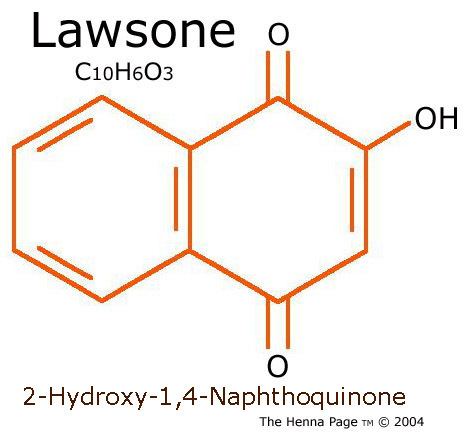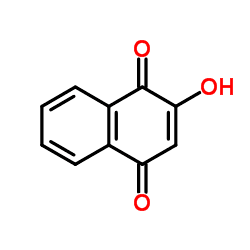Formula C10H6O3 Appearance Yellow prisms | Molar mass 174.15 g/mol | |
 | ||
Lawsone (2-hydroxy-1,4-naphthoquinone), also known as hennotannic acid, is a red-orange dye present in the leaves of the henna plant (Lawsonia inermis) as well as in the flower of water hyacinth (Eichhornia crassipes). Humans have used henna extracts containing lawsone as hair and skin dyes for more than 5000 years. Lawsone reacts chemically with the protein known as keratin in skin and hair, in a process known as Michael addition, resulting in a strong permanent stain that lasts until the skin or hair is shed. The darker colored ink is due to more lawsone-keratin interactions occurring, which evidently break down as the concentration of lawsone decreases and the tattoo fades. Lawsone strongly absorbs UV light, and aqueous extracts can be effective sunless tanning and sunscreens. Chemically, lawsone is similar to juglone, which is found in walnuts.

Lawsone isolation from Lawsonia Inermis can be difficult due to its easily biodegradeable nature. Isolation involves four steps:
- extraction with an extraction solution, usually NaOH
- column filtration using a macroporous adsorption resin
- a rinse with ethanol to remove impurities, and finally
- freeze the product to isolate the lawsone powder, usually a yellow colored dust.

During the rinse, the lawsone will be the bottom as it has such a high density and the chlorophyll molecules will all be on the top of the mixture.
Lawsone is hypothesized to undergo a reaction similar to Strecker synthesis in reactions with amino acids. Recent research has been conducted on lawsone's potential applications in the forensic science field. Since lawsone shows many similarities with ninhydrin, the current reagent for latent fingerprint development, studies have been conducted to see if lawsone can be used in this field. As of now the research is inconclusive, but optimistic. Lawsone non-specifically targets primary amino acids, and displays photoluminescence with forensic light sources. It has a characteristic purple/brown coloration as opposed to the purple/blue associated with ninhydrin. Lawsone shows promise as a reagent for fingerprint detection because of its photoluminescence maximized at 640nm, which is high enough that it avoids background interference common for ninhydrin.
Related compounds
The naphthoquinones lawsone methyl ether and methylene-3,3'-bilawsone are some of the active compounds in Impatiens balsamina leaves.
